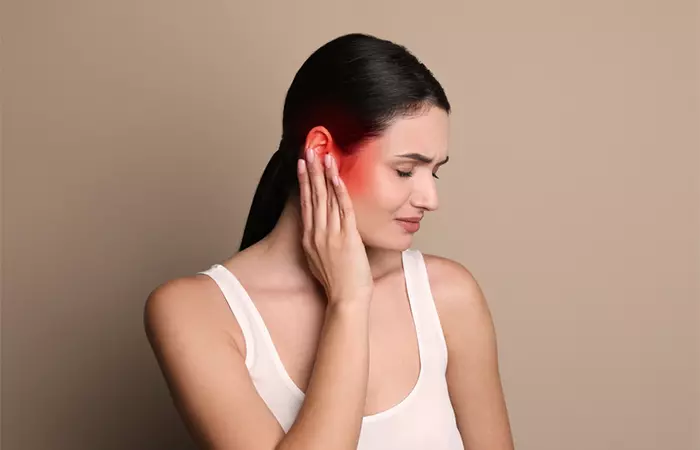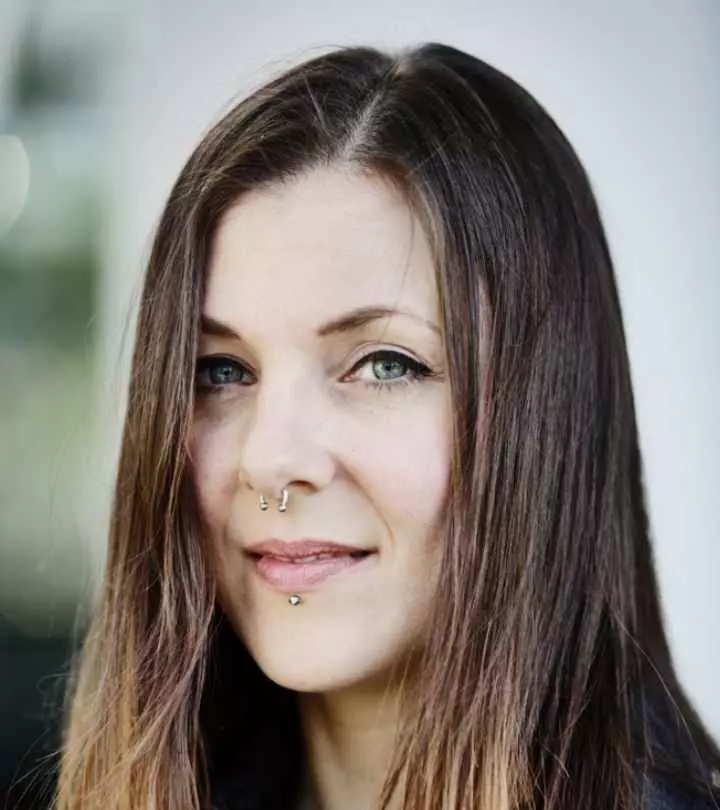Anti-Tragus Piercing: Benefits, Types, Healing, And Jewelry
It’s time to add some spunky edge to your look with this piercing!

Image: StyleCraze Design Team
Move over regular earlobe piercings. The anti-tragus piercing is the new edgy kid on the block! This tiny piercing is nestled in the little cartilage right above your ear canal. Anti-tragus piercing is fast becoming the go-to for those who want something a little different. It is subtle enough to be office-appropriate but packs a punch in the personality department. This piercing trend is the understated act of rebellion you have been searching for – a delicate fusion of elegance and edginess. Keep reading to learn more about this unique piercing and explore stylish ways to embrace this trend!
 Piercing Guide: Anti-Tragus Piercing
Piercing Guide: Anti-Tragus Piercing- Placement: The outer cartilage just above the earlobe
- Best Jewelry: Curved barbells, captive bead rings
- Cost: $30 to $180
- Pain Level: High
- Healing Time: 6 to 12 months
In This Article
Benefits Of Anti-Tragus Piercing
View this post on Instagram
Apart from the aesthetic charm it adds to your ear, anti-tragus piercing is known for its relatively quick healing time compared to some other cartilage piercings. Thanks to the strategic placement in the raised fold on the outer side of the ear, this type of cartilage piercing tends to experience less friction and movement. This promotes a smoother healing process.
Some also believe that its location on the outer cartilage of the ear aligns with acupressure points linked to managing dizziness, motion sickness, and even headaches. Like pressing an acupressure point on your wrist for nausea, the theory goes that the constant stimulation from the piercing might send calming signals to your nervous system, potentially easing these issues.
However, it is important to remember that these are just anecdotal evidence, not scientific proof. There is a lack of studies on the specific benefits of anti-tragus piercings. In addition, everyone’s anatomy and sensitivity are unique, so what works for one person might not work for another.
 Did You Know?
Did You Know?An anti-tragus piercing balances out a prominent chin or softens a strong jawline, adding a delicate counterpoint to angular features. Its angular placement can visually elongate round faces, giving them a more sculpted look.
And then there is the jewelry playground! From dainty studs to shimmering cartilage hoops, and playful charms to edgy spikes, the options are endless. You can match your mood, experiment with your style, or keep it classic and elegant. Learn more about the different types of anti-tragus piercings in the next section.
Key Takeaways
- Anti-tragus piercings are known for their strategic placement on the outer ear, which offers unique styling options.
- The diverse types of anti-tragus piercings, from singles to doubles, provide a range of options for personalization and are ideal for those who wish to experiment.
- Pain perception varies, but it is generally considered bolder compared to lobe piercings.
- Choosing an experienced professional for cartilage piercings such as anti-tragus ensures a smoother and less painful experience.
Types Of Anti-Tragus Piercings
There are various anti-tragus piercing options. Some might prefer the understated elegance of a single stud, while others the bold impact of a stacked cluster. Each boasts a distinctive appeal. Keep reading to learn more!
- Single Anti-Tragus Piercing
View this post on Instagram
A single anti-tragus piercing involves piercing the fold of cartilage on the outer side of the ear opposite the tragus. This classic option allows you to wear different types of jewelry choices, such as studs, flat discs, single loop pieces, cartilage hoops, gold hoop earrings, circular barbells, or captive bead rings. Hence, it is a versatile and customizable piercing; be it minimalist ear piercing ideas or chunky handmade pieces, feel free to include with the help of an experienced piercer.
- Double Anti-Tragus Piercing
View this post on Instagram
This piercing involves two piercings in the anti-tragus area. The symmetrical placement offers a unique and balanced appearance. It also provides opportunities to mix and match different jewelry pieces such as micro stud styles. You can try various pieces of jewelry such as curvy piercing studs, circular horseshoe barbells, silver hoop earrings, cartilage hoop earrings, or double cartilage hoops.
You can opt for something more complex by styling your anti-tragus piercing with other types of ear piercings such as helix piercing (on top of your ear cartilage), conch piercing (goes through the middle part of the ear’s cartilage), auricle piercing (on the outer rim of the ear’s cartilage), or daith piercing (goes through the innermost cartilage fold of the ear, near the ear canal).
These ear cartilage piercings can enhance your anti-tragus piercing as they allow you to wear helix earring hoops, conch hoops, layered tragus hoops, and lobe earrings, along with your anti-tragus hoops.
Before you choose your perfect anti-tragus piercing, it is essential to consider the pain factor. So, let us delve into the level of pain it involves in the next section.
Anti-Tragus Piercing – Pain Level

Anti-tragus piercings are definitely on the bolder side of the spectrum when it comes to pain. It is cartilage, so expect a sharper pinch compared to lobe piercings. Some individuals describe it as a quick sting, while others might feel a little more pressure.
Pain perception varies from person to person, but many report that cartilage piercings can be more uncomfortable than earlobe piercings as cartilage tissue is denser. It also depends on the experience level of your body piercer. It is essential to choose a professional piercer who is experienced in cartilage piercings to ensure a smooth and less painful experience.
 Quick Tip
Quick TipRemember, everyone’s pain tolerance is different! Individual perceptions of pain differ widely, depending on things like anxiety levels and pain thresholds. Take a deep breath, trust your body piercer, and soon you will be sporting that new bling.
As the pain of your anti-tragus piercing starts to fade, so begins another chapter – the healing process. To understand how to navigate it, check out the next section.
Anti-Tragus Piercing – Healing Time And Aftercare
This cartilage piercing takes its sweet time to heal, typically up to 6–12 months. Cartilage piercings, including those in the ear, generally take longer to heal compared to standard earlobe piercings. This is due to the poor blood supply to cartilage tissues. Hence, make sure you are gentle with your fresh piercing. Stick to your piercer’s aftercare routine religiously.
Cleaning with a sterile saline solution 2-3 times a day should be your mantra. Avoid swimming, using harsh soaps, and putting on headphones in the early days. You should also avoid touching the piercing with dirty hands. To prevent friction, sleep on the opposite of the piercing in case you are a side sleeper. Be patient and allow your body the time it needs to heal.
These general guidelines cover what all you must do to take care of the piercing. For an exact step-by-step account of how to clean it, check out the next section.
How Do I Clean An Anti-Tragus Piercing?

Cleaning your anti-tragus piercing is simple and does not require extraordinary care. You can follow these steps as suggested by the Association of Professional Piercers (APP), California:
- Wash your hands gently with antibacterial soap and warm water.
- Soak a piece of gauze or clean pad in a sterile saline solution.
- Gently hold the gauze around the piercing for a few minutes to soften any crusties.
- Gently rotate the jewelry during cleaning to prevent it from sticking to the surrounding tissue.
- Do not pick or pull at the crust, simply rinse it away with the saline solution.
- Pat the area dry with a clean, lint-free towel.
- Do not touch the jewelry piercing with unwashed hands.
While we have covered the cleaning routine, there may still be a few potential bumps on the road. Do not panic as most are normal and easily managed. Let us look at them in the next section.
Side Effects Of An Anti-Tragus Piercing

Like any piercing, there is a chance of swelling, pain, redness, and some mild crusties in anti-tragus piercing as well. In rare cases, infections may occur if proper aftercare is not followed (1).
If the pain worsens, the discharge turns green or smelly, or if you experience fever and persistent throbbing, chances are that you have an infected tragus piercing. Having a detailed knowledge of symptoms can allow you to seek the appropriate treatment as soon as possible. Consulting a healthcare professional immediately is also a wise choice (1).
If you follow these instructions, you should be able to handle any side effects like a champ. Now, benefits and side effects aside, there is also the question of cost. Let us find out how much an anti-tragus piercing can set you back in the next section.
How Much Does An Anti-Tragus Piercing Cost?
Prices can vary depending on location, piercer’s experience, and the jewelry. Typically, you can expect to pay somewhere between $30 and $180.
Remember, quality matters! Do not skimp on a piercing to get it done for cheap. Invest in a piercing professional who uses sterile equipment, follows safe practices, and advocates for proper aftercare.
There is one more thing before you start digging through Pinterest for sparkly inspiration, and that is when to change your anti-tragus jewelry. Find out in the following section.
When Can I Change My Anti-Tragus Piercing?
Resist the urge to switch studs too soon! Ideally, you should wait 6 months before considering a jewelry change. If you cannot wait that long, you should wait at least 3 months.
Cynthia Dam, a YouTuber who recently changed her anti-tragus piercing, shared her experience in her video. She shared, “I finally swapped up my anti-tragus for a ring. I’m here for this minimal ear game, you know (i).” Cynthia noted that the experience was uncomfortable but not overly painful and mentioned, “If you’re really sensitive to pain, it probably would have been like a 1 or 2 [out of 5].”
Let your piercing heal properly before introducing new metal or fiddling with it. It is important to listen to your body. If there is any discomfort or resistance when attempting to change the jewelry, give it more time. Once you are ready, your experienced piercer can help you choose the perfect new piece and guide you through the safe switch-up process.
An anti-tragus piercing is a balanced blend of dainty and edgy. Nestled strategically in the outer ear cartilage, it is an ideal choice for those seeking a distinctive look. As you navigate the pain, healing journey, and other potential complications from skin sensitivities during the process, it is important to approach it with patience and care. Regardless, this piercing stands as a canvas for personal expression and creativity.
Frequently Asked Questions
What kind of jewelry is used for an anti-tragus piercing?
Typically, a small stud or a captive bead ring is used for an anti-tragus piercing. The choice depends on your preference and the advice of your body piercer.
What jewelry material is used for an anti-tragus piercing?
Commonly, jewelry for an anti-tragus piercing is made from materials such as surgical stainless steel, titanium, silver stainless material, or gold. Opting for hypoallergenic materials is wise for those with sensitive skin as it minimizes the risk of adverse reactions and keeps infection at bay.
Can I get an allergic reaction to my anti-tragus jewelry?
While rare, it is possible to get an allergic reaction to jewelry metals like nickel and alloys containing it (2). Watch out for redness, itching, or swelling around the piercing. Talk to your professional piercer or doctor about switching to other jewelry material options.
How do you give yourself an anti-tragus piercing?
We strongly advise against attempting self-piercing due to the risk of improper placement which may increase pain. Always seek a professional piercer to ensure a safe piercing experience.
Why shouldn’t I get an anti-tragus earring?
If you have concerns about its potential pain, prolonged healing period, or compatibility with your lifestyle, it is essential to weigh the pros and cons before getting it. Consulting with a professional piercer can help address specific concerns and provide guidance tailored to your circumstances.
Discover the artistry of anti-tragus piercing in the following YouTube video as an expert body piercer guides you through the piercing procedure. Watch and learn different ways to ensure precision and safety during the process!
Personal Experience: Source
StyleCraze's articles are interwoven with authentic personal narratives that provide depth and resonance to our content. Below are the sources of the personal accounts referenced in this article.
(i). SWAPPING MY ANTI-TRAGUS JEWELRY FOR A HOOP VLOG | inspiroue
https://www.youtube.com/watch?v=cwElin37yYw
References
Articles on StyleCraze are backed by verified information from peer-reviewed and academic research papers, reputed organizations, research institutions, and medical associations to ensure accuracy and relevance. Read our editorial policy to learn more.
- Body piercing
https://www.ncbi.nlm.nih.gov/pmc/articles/PMC1127091/ - Body Piercing Infections
https://www.ncbi.nlm.nih.gov/books/NBK537336/
Read full bio of Rodrigo Casco
Read full bio of Vaishali Sinha
Read full bio of Subhrojyoti Mukherjee
Read full bio of Shreya Mukherjee
























Community Experiences
Join the conversation and become a part of our empowering community! Share your stories, experiences, and insights to connect with other beauty, lifestyle, and health enthusiasts.